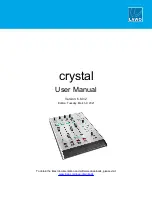
Cleaning agents with chlorine or chloride as the active ingredient are corrosive to stainless steel and must
not be used. Saline solution has a corrosive effect on stainless steel and should not be used.
Do not process the dermatome handpiece or accessories in an automatic washer/sterilizer.
Never clean in an ultrasonic cleaner. Ultrasonic cleaning will dislodge oil from the bearings and render the
instrument inoperative. Ultrasonic cleaning may affect calibration of the Zimmer Electric Dermatome.
Never sterilize the power supply or immerse it in any solution.
Steam sterilize the Zimmer Electric Dermatome and accessories (except power supply). Follow
instructions in STERILIZATION RECOMMENDATIONS.
CLEANING INSTRUCTIONS FOR THE DERMATOME
• Ensure the Zimmer Electric Dermatome has been fully disconnected from the power supply.
• Use caution when handling the dermatome to determine that the used blade has been removed. If not,
safely dispose of all used blades in accordance with hospital policy for contaminated waste and sharps.
• Never let water or detergent enter the handpiece. Permanent damage may result. (See Fig. 13.)
• Remove excess body fluids and tissue with a disposable, non-shedding wipe and cover with a damp
cloth. Body fluids and tissue should not be allowed to dry on instruments prior to cleaning.
• Universal precautions for handling contaminated/biohazardous materials should be observed.
• Instruments should be cleaned within 30 minutes of use to minimize the potential for drying prior to
cleaning.
• Prepare cleaning agents at the use-dilution and temperature recommended by the manufacturer.
• Thoroughly scrub the instrument with a soft-bristled brush and a pH neutral detergent. If desired, a
neutral pH enzyme solution may be used prior to scrubbing with the detergent. Use the soft-bristled brush
to gently clean the instrument, paying particular attention to any crevices and other hard-to-clean areas
until all visible soil has been removed. (See Fig. 12.) Note: the cleaning solution should be changed if it
becomes grossly contaminated (bloody and/or turbid).
• The thickness control lever should be moved during cleaning to release any debris which may be
trapped under the lever or in the notches.
• The cavity which housed the oscillating drive pin should be rinsed clean and the water shaken out. This
will prevent the accumulation of deposits in this cavity.
• Rinse all detergent from the instrument. Purified water (from one or any combination of the following
processes: ultra-filter, RO, DI and/or distilled) is recommended. (See Fig. 13.)
• If there continues to be blood or soil in the rinse stream, repeat proceeding two steps with freshly
prepared cleaning solution.
• Dry the instrument with a clean, disposable, absorbent, non-shedding wipe. (See Fig. 14.)
• Carefully inspect each instrument to ensure that all visible blood and soil has been removed.
Содержание Electric Dermatome
Страница 11: ...A Autoclave Case B Power Supply C Screwdriver D Width Plates E Handpiece ...
Страница 13: ...A Screwdriver B Width Plate C Blade D Drive Pin Hole E Drive Pin ...
Страница 14: ......
Страница 15: ......
Страница 16: ...METHOD I A Handpiece B Pocket METHOD II A Handpiece B Forceps ...
Страница 17: ......
Страница 18: ......
Страница 19: ......
Страница 20: ......
Страница 21: ......
Страница 22: ......







































